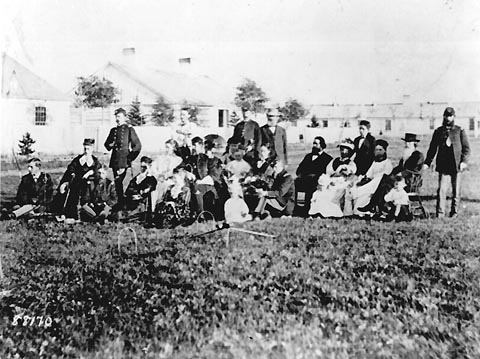 Ft. Bridger, Wyo., 1873
Fort Bridger, 1849 view from Stanbuy Expedition below left, unlike most other forts on the Oregon Trail,
was founded as a privately owned and operated facility to provide provisions, at
outrageous prices, to emigrants on the Oregon Trail .
One emigrant, Edwin Bryant, described it during its early years: "The buildings are two or three miserable
log cabins, rudely constructed and bearing
but a faint resemblance to habitable houses." 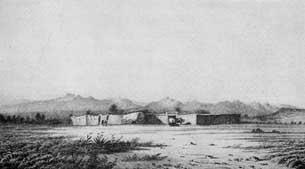 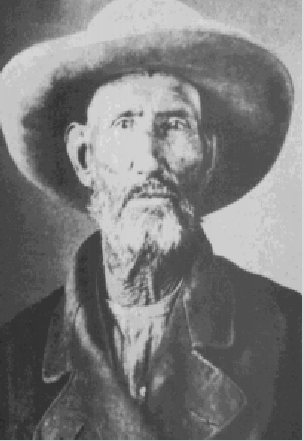 Left, 1849 view from Stanbury Expedition
Left, 1849 view from Stanbury Expedition
Right, Jim Bridger
The fort was built in 1843 by Jim Bridger and his partner Louis Vasquez who operated it for less than ten years.
It was burned down during the Mormon War in 1857, along with Ft. Supply 12 miles to the Southwest, by
the L.D.S. who claimed, over Bridger's denials, they had purchased the fort from Vasquez. The Fort was assumed
by the military under Albert Sidney Johnston in 1858, photo lower left.
It was the site of the first piano, brought by ox drawn wagon from St. Louis,
and school house in the Territory. Its importance declined when by-passes were constructed, such
as the Lander Cutoff
, the first road in the Rockies, built in 1858. Frederic W. Lander was the chief engineer for the construction
of the Pacific Wagon Road from Independence, Mo. to Honey Lake, Ca. Lander's
most significant accomplishment was the location and construction
of the Cutoff from South Pass to a point near Soda Springs. The advantage of the Lander
Cutoff was that it provided better water, wood, and forage than the older route. During its
first year, 1859, 13,000 emigrants utilized the new route. The Lander Cutoff remained in use until 1912.
For more on Lander Expedition see next page.
Military use of the Fort Bridger
was abondoned in 1890. 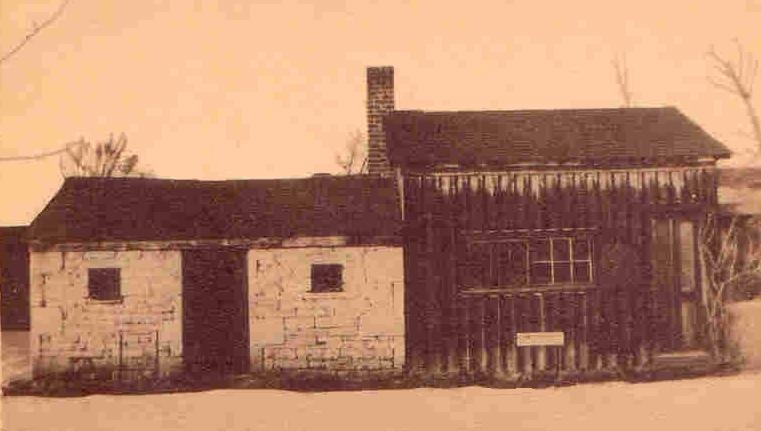
School House at Fort Bridger, undated
The school at Fort Bridger was established in 1860 by the fort sutler, Judge William A. Carter, with its
first teacher being Fannie Foot. In the Fort Bridger treaty of 1868 with the Shoshoni, the Government
pledged to establish a school at Fort Washakie at a cost of not more than $2,500. The first teacher
at Fort Washakie was James J. Chander (1849-1927). The first class has 35 students, both Indian and
white. Prior to the formation of schools children would have to attend boarding schools elsewhere. Jim Bridger,
as an example, sent his daughter to a missionary school in Oregon. Unfortunately,
the mission was attacked by Indians, the missionaries killed, and Bridger's daughter
kidnapped by the Indians. She was never heard of again.
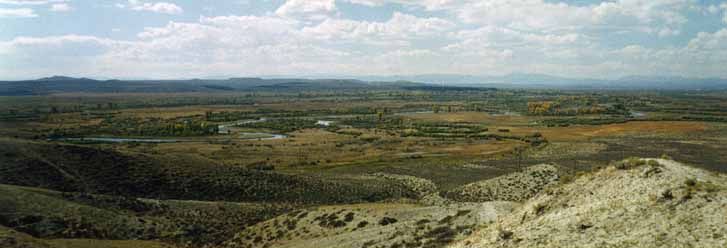
Green River near Pinedale*
Rendezvous were conducted in Wyoming beginning in 1825 with the first being near present
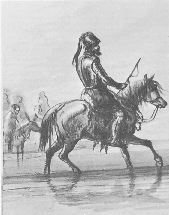 day Burnt Fort.
The Rendezvous of 1833, '35, '36, '37, '39 and 1840 were held at the confluence of Horse Creek and the
Green River near present day Pinedale. Those of 1830 and 1838 on the Wind River near Riverton,
that of 1829 near Lander, and that of 1834 at Ham's Fork near
present day Kemmerer. Those of 1826, '27, '28, 31, and '32 in present day Utah or Idaho. day Burnt Fort.
The Rendezvous of 1833, '35, '36, '37, '39 and 1840 were held at the confluence of Horse Creek and the
Green River near present day Pinedale. Those of 1830 and 1838 on the Wind River near Riverton,
that of 1829 near Lander, and that of 1834 at Ham's Fork near
present day Kemmerer. Those of 1826, '27, '28, 31, and '32 in present day Utah or Idaho.
Bridger, 1837 rendevous, pencil sketch by Alfred Jacob Miller. See text
below.
At the 1835 Rendezvous Dr. Marcus Whiteman, husband of Narcissa Whiteman one of the first two Anglo-American women to cross the
continent overland to Oregon, removed, to the amusement and amazement of the ensembled
multitudes, a three inch arrow or spearhead that had been lodged in Jim Bridger's shoulder for the
preceeding three years. Two years later at the 1837 Rendezvous, Capt. Sir William Drummond Stewart presented Bridger with a
replica suit of armor brought from Britain. Bridger, drunk, proceeded on horseback to clank around the rendezvous grounds in the armor.
Sir William, a veteran of Waterloo and an excellent marksman, attended each rendevous from 1833 to 1837,
bringing nothing but the finest provisions.
The 1837 Rendezvous was attended by more than 2,000 trappers, traders and Indians. Styles had already begun to change and top money
was not received for the furs. Three years later less than 140 whites attended the 1840 Rendezvous and, with the expense of
bringing goods by wagon from St. Louis, it was announced that no further rendezvous would be held.

Fort Bridger, undated but believed to be approx. 1920's
Other members of the British peerage conducted early expeditions to the West. Among the more
notable was Sir George Gore's 1855-56 hunting trip out of Fort Laramie guided by Jim Bridger. Sir George did it up in
fine style with 40 attendants, 6 wagons, 23 wheeled carts, 75 shooting rifles, china, crystal, linens,
and a collapsible brass bed. On the trip, 6,000 bison, 1,600 elk and 105 grizzlies were killed. At Fort Union,
Sir George, in a dispute relating to the sale of some of the equipment,
ordered everything burned except the arms and alcohol. While the wagons and
carts burned, the spectators consumed the alcohol. The last item thrown into the confligration was the
expedition journal. The expedition continued, however, until it came to an unexpected halt
near present day Sundance when the Sioux stole the expedition's horses, arms and
clothes. Sir George and his men survived the ordeal, but Sir George died on the
return trip to Britain. 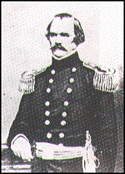 Albert Sidney Johnston
Albert Sidney Johnston
For his services during the Mormon War, Johnston conferred the honorary title of "major"
on Bridger. Although Bridger could not read or write he loved to be read
to, even to the extent that at one point he employed an
individual to read to him. He was particularly fond of Shakespeare and managed to memorize a large number of
passages which he would recite. Two explainations have been given for Bridger's love
of Shakespear. One is that Sir George Gore introduced Bridger to the bard. Another was given by
Eugene F. Ware (1841-1911) in his 1911 book, The Indian War of 1864:
The largest building in camp[See Ft. Laramie]
was called Bedlam. It was the two-story large hospital building
fronting on the parade-ground, and the upper part of it was used
for theatricals at times. There were always some soldiers who were
good at private theatricals, and occasionally there was one who had
been an actor. So, during the long and tiresome winter evenings there
were theatrical entertainments frequently. They were generally of some
light, witty, flashy kind, with an occasional heavy piece from Shakespeare.
Bridger had seen a couple of Shakespeare's pieces well played at the post,
and concluded he would like to have somebody read Shakespeare to him. So,
he had the sutler, Mr. Ward, send and get him a copy of Shakespeare, and
Bridger got a man, a soldier, to start reading it to him. One evening while
sitting in front of the adobe fireplace reading Shakespeare the soldier
got to reading in the play where the eyes of the two boy princes were put
out. After it had been read Bridger says, "Did he do that?" and when the
reader said, "Yes," Bridger pulled the book from him and said, "By thunder,
that is what I think of him," and threw the book into the fire, blazing
in the fireplace, and that was all of Shakespeare he ever wanted to hear.
In his later years Bridger became almost blind and
would ride around his farm in Missouri on a tame horse accompanied by his dog. When
Bridger would sometimes become lost due to his blindness. The dog would then, like Rin Tin Tin, run
back to the house to get someone to lead the great guide home. Bridger
died a natural death, unlike many of his compatriots, at his farm in Kansas City July 17, 1881, age 77.
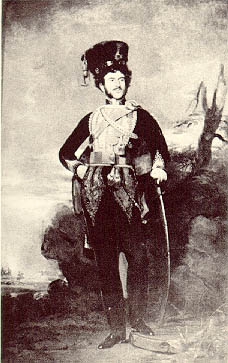 Captain Sir William Drummond Stewart, painting by Alfred Jacob Miller. See
text above.
Captain Sir William Drummond Stewart, painting by Alfred Jacob Miller. See
text above.
The outdoor life was not a healthy life for the early mountain men. Jacques LaRamee disappeared to do beaver trapping
along a tributary of the Platte. Bridger in 1868 told John Hunton that he had been a part of the
1821 search party which found only a half completed cabin and a broken beaver trap. Bridger indicated that
two years later he was told by the Arapaho that they had killed LaRamee and
placed his body under the ice behind a beaver dam. Three of the five Sublette Brothers died early: Pickney was killed by the
Blackfeet at the Battle of Pierre's Hole in 1832; Andrew died as a result
of being mauled by a grizzly and
Milton died of a leg infection at Fort Laramie after several amputations.
Jedediah Strong Smith was killed by
a Comanchee Arrow along the Cimmaron in 1831. William Guerrier blew himself to Kingdon Come during the winter of 1857-58 when one of his employees left a
keg of black powder on the front of a wagon with the lid off. Guerier, sometimes referred to in government
records as "Bill Garey", in stepping on the the tongue of the wagon accidently allowed some embers from his pipe to fall into the
open keg. Guerrier was noted as a proficient interpreter for the Cheyenne and ran the first cattle ranch in Wyoming near
Register Cliff near present day Guernsey. Guerrier, son-in-law of Gray Thunder, was the father of Edmond Guerrier, a survivor of
the Battle of Sand Creek. Edmond testified before Congress as to the slaughter.
Johnston bled to death as a result of a minor wound at Shiloh April
6, 1862, the same battle in which John Wesley Powell lost his arm.
*Green River Photo from Mountain Men and the Fur Trade
Next page: Lander and the Fremont Expeditions.
|